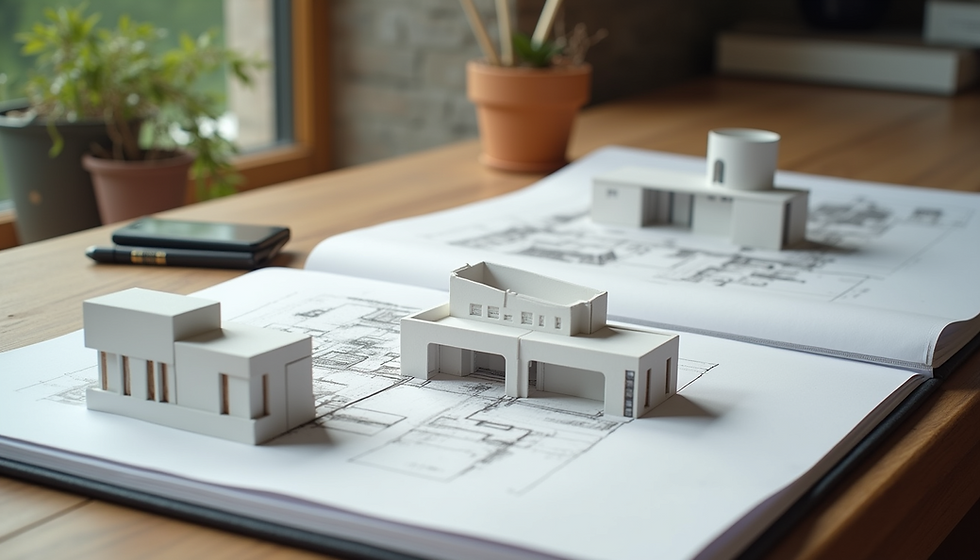Blueprints for Tomorrow: Designing India's Futuristic Cities
- Nov 2
- 4 min read
India is on the cusp of a remarkable transformation. As urban populations swell and technology advances, the need for futuristic cities that blend sustainability, innovation, and livability has never been greater. Designing these cities requires a thoughtful approach that balances rapid growth with environmental responsibility and social inclusivity. This blog explores the key elements shaping India's futuristic cities and how they can become models for urban development worldwide.
The Rise of Futuristic Cities in India
Futuristic cities are not just about sleek skyscrapers and smart gadgets. They represent a holistic vision where technology, infrastructure, and community coexist harmoniously. In India, this vision is gaining momentum with projects like smart cities and green urban spaces.
Key features of futuristic cities include:
Sustainable infrastructure: Use of renewable energy, efficient water management, and waste recycling.
Smart technology integration: IoT devices for traffic control, energy use, and public safety.
Green spaces: Parks, urban forests, and rooftop gardens to improve air quality and provide recreation.
Affordable housing: Ensuring all income groups have access to quality living spaces.
Efficient public transport: Reducing congestion and pollution through metro systems, electric buses, and bike lanes.
For example, the city of Pune is integrating smart traffic management systems to reduce congestion and pollution. Similarly, the Amaravati project in Andhra Pradesh aims to be a green, tech-enabled capital city.

Innovations Driving Futuristic Cities
Technology is the backbone of futuristic urban design. India is leveraging innovations to address its unique challenges:
Smart grids and renewable energy: Cities are adopting solar and wind power, combined with smart grids that optimize energy distribution.
Water conservation technologies: Rainwater harvesting, wastewater recycling, and smart meters help manage scarce water resources.
AI and Big Data: These tools analyze traffic patterns, energy consumption, and public health data to improve city services.
Electric mobility: Electric vehicles and charging infrastructure reduce carbon emissions and dependence on fossil fuels.
Modular construction: Prefabricated building components speed up construction and reduce waste.
Hyderabad’s Genome Valley is an example of a tech-driven urban hub, combining biotech innovation with sustainable infrastructure. Similarly, the Delhi-Mumbai Industrial Corridor is planned with smart city principles to boost economic growth while minimizing environmental impact.
Which city has the best future in India?
Among the many contenders, GIFT City (Gujarat International Finance Tec-City) stands out as a frontrunner. It is designed as a global financial hub with state-of-the-art infrastructure, smart technology, and sustainable urban planning.
Key reasons why GIFT City is promising:
Integrated smart systems: Automated waste management, smart lighting, and surveillance.
Green building standards: Most buildings comply with LEED certification.
Efficient transport: Seamless connectivity with metro and bus rapid transit systems.
Economic incentives: Special economic zones attract global businesses.
Quality of life: Ample green spaces, recreational facilities, and affordable housing.
Other cities like Pune, Bengaluru, and Amaravati are also making significant strides, but GIFT City’s comprehensive approach makes it a model for future urban development in India.

Challenges in Building Futuristic Cities
Despite the exciting prospects, several challenges must be addressed:
Land acquisition and urban sprawl: Securing land without displacing communities is complex.
Funding and investment: Large-scale projects require sustained financial support.
Infrastructure integration: Coordinating transport, utilities, and communication networks is difficult.
Social inclusivity: Ensuring marginalized groups benefit from development.
Environmental concerns: Balancing growth with conservation of natural resources.
To overcome these, city planners must engage local communities, adopt transparent governance, and prioritize sustainable practices. Public-private partnerships can also mobilize resources and expertise.
Practical Steps for Designing Futuristic Cities
Designing futuristic cities in India involves a multi-faceted approach. Here are actionable recommendations:
Adopt a master plan with sustainability goals: Set clear targets for energy use, waste reduction, and green cover.
Leverage technology for smart governance: Use data analytics to optimize city services and enhance citizen engagement.
Promote mixed-use development: Combine residential, commercial, and recreational spaces to reduce commute times.
Invest in public transport and non-motorized mobility: Encourage walking, cycling, and efficient mass transit.
Encourage green building practices: Incentivize developers to use eco-friendly materials and designs.
Foster innovation hubs: Create zones for startups and research institutions to drive economic growth.
Ensure affordable housing: Implement policies that support low-income residents.
Plan for climate resilience: Design infrastructure to withstand floods, heatwaves, and other climate risks.
By following these steps, India can create cities that are not only futuristic but also inclusive and resilient.
The Road Ahead for India’s Urban Future
India’s journey towards futuristic cities is both exciting and challenging. With rapid urbanization, the need for smart, sustainable, and inclusive cities is urgent. By embracing innovation, prioritizing sustainability, and fostering collaboration, India can build urban spaces that improve quality of life and set global standards.
For those interested in exploring more about the design and development of futuristic urban spaces, resources like india futuristic city offer valuable insights and case studies.
The blueprint for tomorrow’s cities is being drawn today. With vision, commitment, and smart planning, India’s futuristic cities will not only be places to live but also symbols of progress and hope for generations to come.



Comments